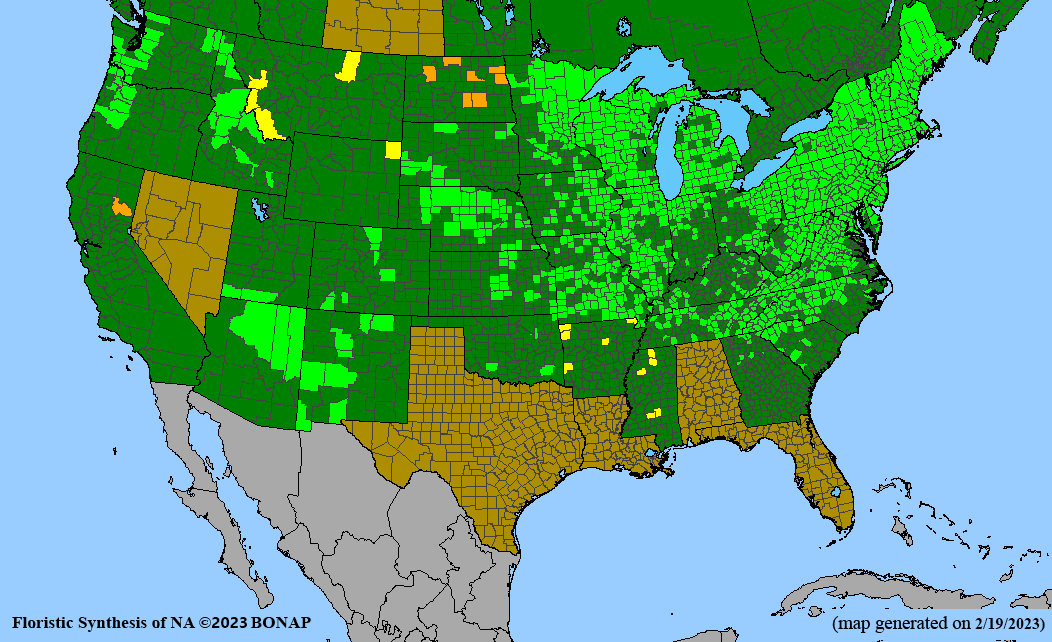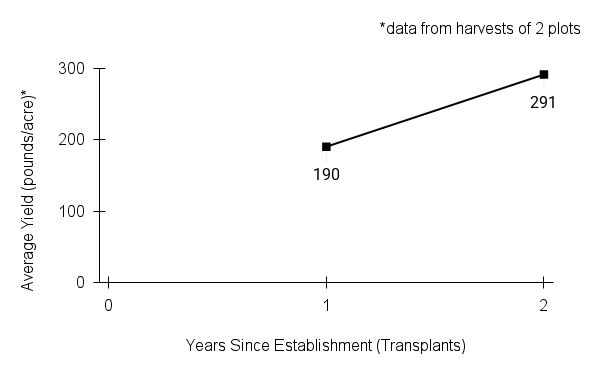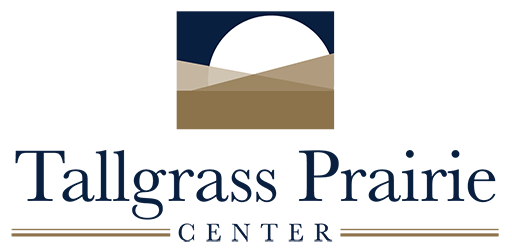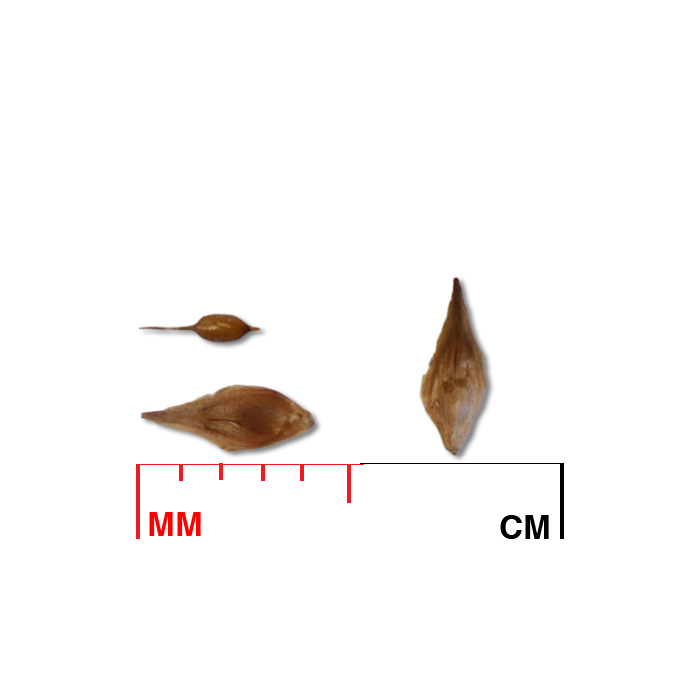broom sedge
Table of Contents
Carex scoparia Schkuhr ex Willd.
Alternate Common Names: pointed broom sedge, lance-fruited oval sedge
Scientific Synonyms: Carex scoparia Schkuhr var. moniliformis Tuckerm., Carex scoparia Schkuhr var. condensa Fern.
Family: sedge family (Cyperaceae)
Functional Group: sedges and rushes
Description
- Life cycle and growth form
perennial, fibrous rooted, short-rhizomatous, clump forming
Height: 1-2.5 ft
- Leaves and stem
Leaves flat and hairless with rough margins, alternate arrangement, 3-ranked, shorter than flowering stems; top of sheath around flowering stem (culm) has a ‘u’ or ‘v’ shaped notch, basal sheaths are brown and fibrous; culm is hairless and 3-sided, smooth and unbranched.
- Flower, fruit and seedhead
Fruit/seedhead: 3-10 spikes per culm, each up to 2/3 in (10-15 mm) long, often crowded at the end of the culm but still distinct as individual elliptical to oval spikes; golden-tan color at maturity, stem may bend or arch at the tip or be straight.
Pollination: wind
- Seed
Seed characteristics
Seed weight:
Seeds per ounce: 84,000 seeds/oz (IA NRCS)
1000 seed weight: 0.44g (Seed Information Database)
Description: “seed” is an ovate to elliptic, brown achene that is enclosed in a perigynium; perigynium is golden-tan, flat, and hairless, 5-veined on each side, lance-shaped and often 3-4 times as long as wide.
Typical seed test
PLS: 93% (n = 5)
Purity: 96% (n = 5)
Germination: 50% (n = 3)
Dormancy: 66% (n = 5)
(averages obtained from n tests of purchased seed lots)
- Habitat and range
Habitat: Moist to wet soil; partial to full sun; prairies, shorelines, swales, fens, seeps, marshes, ditches; Wetland Indicator Status is Facultative Wetland (FACW) for the Midwest.
Conservation status: Global- G5, secure; North Dakota- SH, possibly extirpated; Arkansas, Utah, and Wyoming- S1, critically imperiled; Montana- S1/S2, critically imperiled to imperiled; Georgia- S3, vulnerable (NatureServe)

General Comments
Sedges are a large, diverse group of grass-like plants that are important components of prairies, wetlands, and woodlands across our region. In Iowa alone, there are about 120 species of sedges. Grasshoppers and the larvae of skippers and other butterflies and moths feed on sedge foliage, and their seeds are eaten by grassland birds and waterfowl. They are notoriously difficult to identify to species, especially the oval sedges to which broom sedge belongs. The development of stock seed by the Tallgrass Prairie Center in the early 2000s enabled broader access to reliably identified sedge species by native seed growers. Broom sedge is found naturally in moist to wet soils and may benefit from supplemental watering in seed production systems.
Recommendations for Seed Production
- Establishment for seed production
Direct seeding
We do not recommend direct seeding for this species.
Greenhouse
Seed pre-treatment: Benefits from cold-moist stratification for 30 days.
Sowing: Sow in germination flats or directly into plugs (2-3 seeds per cell), covering seed lightly (light improves germination of many sedge species); maintain even moisture until germination. Daytime temperatures should be around 70-80°F (22-27°C) and allowed to drop at night to 50-60°F (10-15°C). We have had good success planting into 2.5 in deep, 73-cell plug flats that are ridged to direct root development downward and have 3/4 in bottom openings to encourage root pruning and the formation of firmly rooted plugs for transplanting.
Transplanting: Seedlings are ready to transplant to an irrigated field about 10 weeks after sowing. Pop out a few plugs to check for adequate root development that will provide sturdy plugs for planting. A week or two before transplanting, move flats outside to ‘harden off.’
- Stand management
Weeds: Plastic mulch reduces weed pressure in the first year or more. Holes in the plastic should be widened somewhat in subsequent years to allow the bunches to expand. Bunching plants are robust and leafy, competing well with many weeds; we have interplanted broom sedge with cardinalflower to provide support and reduce weed pressure (note: interplanting necessitates hand harvest of the sedge and eliminates broadleaf herbicides as an option). In large-scale production systems or those where the use of weed barriers and/or hand weeding is not practical, herbicides (e.g., broad-leaf herbicides and/or pre-emergents) may be useful to prevent weeds from competing with the sedge plants and/or complicating the seed cleaning process. Significant weed problems may be caused by winter annuals (e.g., members of the mustard family), other small-seeded broad-leaf annuals, and annual grasses (e.g., downy brome). Herbicide applications should be timed to most effectively control specific weeds and minimize damage to the sedge plants. Care must be taken to read affected “weed” lists, as sedges are considered weeds in crop systems. Always read and follow label instructions.
Pests: None noted.
Diseases: None noted.
Soil moisture: Irrigation is recommended. Drip tape can be applied under plastic mulch as planting beds are formed.
- Seed production
 First harvest: First harvest one year after transplanting
First harvest: First harvest one year after transplantingYield/acre: 190-290 pounds per acre (extrapolated from cleaned seed harvested from two plots at TPC)
Stand life: Unknown, but plants are likely long-lived and should continue to be productive with proper weed management.
Flowering date: June
Seed maturity/Harvest date: Late June to early July in northeastern Iowa
Seed retention: Moderate risk of shattering at maturity; also vulnerable to lodging, potentially complicating combine harvest.
Harvest date range at TPC (2010-2023): June 28 - July 3
Recommended harvest method: We have harvested small plots using hand sickles; seed threshes easily after drying on tarps. Combining should also work well, if seed is mature.
- Seed cleaning and storage
Cleaning process: Air-dry seed for two weeks or more after harvest. Pass material through a coarse screen (1/2 in hardware cloth) to remove larger stemmy material, if needed, then air screen.
Seed storage: Cool/dry (33-50° F, 30-50% RH)
Released Germplasm
Source Identified material: Natural Selections/Iowa Ecotype Zone IA
- References
Carex scoparia (Pointed Broom Sedge). Minnesota Wildflowers. (n.d.). https://www.minnesotawildflowers.info/grass-sedge-rush/pointed-broom-sedge
Houseal, G. (2010). Plasticulture for seed production of wetland (Carex) species. Native Plants Journal, 11(1), 58-64. https://doi.org/10.2979/NPJ.2010.11.1.58
Kartesz, J.T., The Biota of North America Program (BONAP). 2023. North American Plant Atlas. (http://bonap.net/napa). Chapel Hill, N.C. [maps generated from Kartesz, J.T. 2023. Floristic Synthesis of North America, Version 1.0. Biota of North America Program (BONAP). (in press)]
Kettenring and Galatowitsch (2007) https://www.sciencedirect.com/science/article/pii/S030437700700085X
Kettenring KM, Gardner G, Galatowitsch SM. Effect of light on seed germination of eight wetland Carex species. Ann Bot. 2006 Oct;98(4):869-74. doi: 10.1093/aob/mcl170. Epub 2006 Aug 11. PMID: 16905568; PMCID: PMC2806167.
Mohlenbrock, R. H. (1999). Carex scoparia. In Illustrated Flora of Illinois - Sedges: Carex (p. 108). Southern Illinois University Press.
Murphy, M. & Spyreas, G. & Marcum, P. (2025) Carex of Illinois & Surrounding States: The Oval Sedges. University of Illinois Press
NatureServe. 2024. NatureServe Network Biodiversity Location Data accessed through NatureServe Explorer [web application]. NatureServe, Arlington, Virginia. Available https://explorer.natureserve.org/. (Accessed: February 29, 2024).
Pointed Broom Sedge. Illinois Wildflowers. (n.d.). https://www.illinoiswildflowers.info/grasses/plants/pb_sedge.htm
USDA NRCS National Plant Data Team. (n.d.). Carex scoparia Schkuhr ex Willd.. USDA plants database. https://plants.usda.gov/home/plantProfile?symbol=CASC11
Species Guide Updated 2/7/2025



